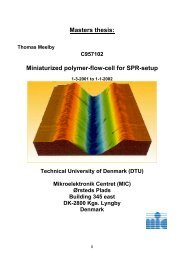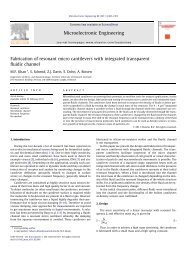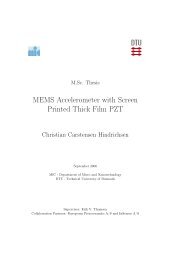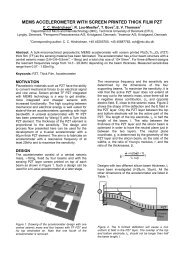Prototyping of microfluidic systems with integrated ... - DTU Nanotech
Prototyping of microfluidic systems with integrated ... - DTU Nanotech
Prototyping of microfluidic systems with integrated ... - DTU Nanotech
You also want an ePaper? Increase the reach of your titles
YUMPU automatically turns print PDFs into web optimized ePapers that Google loves.
Chapter 2<br />
Theoretical aspects –<br />
micr<strong>of</strong>luidics and optics<br />
2.1 Introduction<br />
<strong>Prototyping</strong> <strong>of</strong> micr<strong>of</strong>luidic system is in many ways a cross-disciplinary<br />
field. Knowledge about physics like fluid dynamics, optics, and solid<br />
state physics is required, along <strong>with</strong> chemistry – for instance knowledge<br />
about polymers and solvents – and engineering.<br />
While the design <strong>of</strong> prototypes and the development and refinement<br />
<strong>of</strong> manufacturing methods is <strong>of</strong>ten based on a combination <strong>of</strong> previous<br />
knowledge combined <strong>with</strong> intuition and a trial-and-error approach, it is<br />
still crucial to recognise the underlying physical principles and theories<br />
in play in the <strong>systems</strong>.<br />
Several theoretical issues must be considered when designing and<br />
manufacturing a micr<strong>of</strong>luidic system <strong>with</strong> <strong>integrated</strong> optical waveguides.<br />
If chemical reactions, separation, and/or mixing are to take place, it is<br />
vital that the liquid is properly mixed or separated when measurements<br />
are carried out. If, e.g., a liquid is not sufficiently well mixed when an<br />
absorbance or fluorescence measurement is carried out, erroneous results<br />
are likely to occur, since one might measure a more or less diluted part<br />
<strong>of</strong> the liquid.<br />
When designing a micr<strong>of</strong>luidic network, care must be taken to ensure<br />
that the fluid is led through the system in the proper manner. If the<br />
cross section <strong>of</strong> the micr<strong>of</strong>luidic channel is suddenly increased, e.g. by<br />
going from a channel to a larger reservoir, the drop in the pressure may<br />
generate bubbles in the system. Also, geometrical considerations are<br />
7










